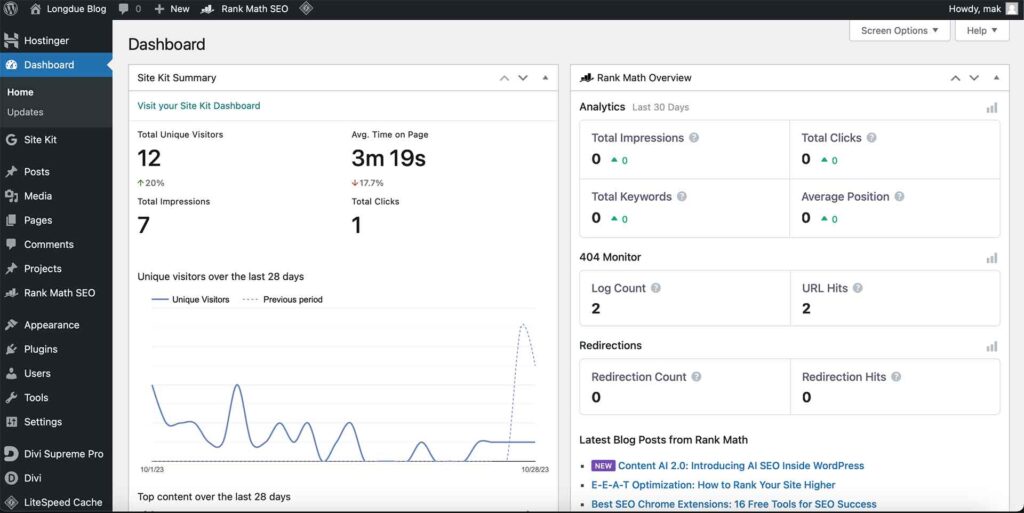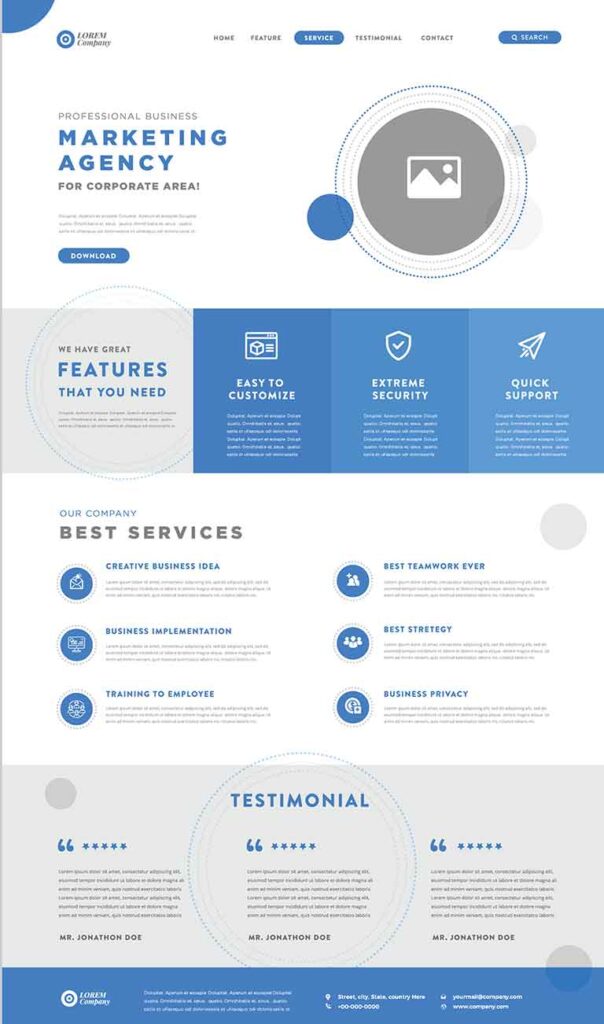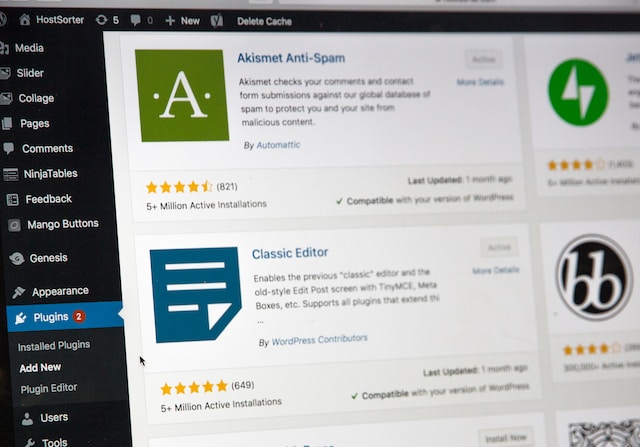WordPress for Beginners: 6 Must-Know Tips for a Smooth Start
Embarking on your WordPress journey is like setting out on a thrilling expedition into the digital world. This platform is a beacon for many, from bloggers to businesses, due to its versatility and user-friendly nature. However, navigating through its features and capabilities can seem daunting for beginners. Fear not, for this guide is tailored to help you understand the intricacies of WordPress, offering six must-know tips to kickstart your journey effectively.
1. Choosing the Right Hosting and Domain: A Deeper Exploration
Embarking on your WordPress journey starts with two fundamental decisions: selecting the right hosting and choosing an appropriate domain name. These decisions lay the groundwork for your website’s performance, accessibility, and overall success. Let’s dive deeper into these critical aspects.

Understanding Web Hosting in Detail
Think of web hosting as the digital real estate where your website lives. It’s crucial because it affects your website’s speed, uptime, and scalability. Here’s a more detailed look at the different types of hosting:
- Shared Hosting:
- What it is: You share a server with other websites. Resources such as memory, storage, and processing power are shared among all the sites on that server.
- Pros: Cost-effective and user-friendly. Ideal for small websites or beginners.
- Cons: Limited resources can lead to slower performance during traffic spikes.
- Examples: Bluehost, HostGator, and SiteGround offer reliable shared hosting plans tailored for WordPress.
- Virtual Private Server (VPS) Hosting:
- What it is: A step up from shared hosting. While you still share a server with other sites, you have dedicated portions of the server’s resources.
- Pros: More control and better performance than shared hosting. Suitable for medium-sized websites.
- Cons: More expensive and may require more technical knowledge.
- Examples: InMotion Hosting and A2 Hosting provide robust VPS hosting options.
- Dedicated Hosting:
- What it is: You get an entire server for your website. No sharing of resources.
- Pros: Maximum control, high performance, and strong security. Ideal for large websites with high traffic.
- Cons: Significantly more expensive and requires technical expertise.
- Examples: HostGator and Bluehost offer dedicated servers with varying levels of management.
- Managed WordPress Hosting:
- What it is: Specifically optimized for WordPress. It includes WordPress-related customer support, automated updates, and enhanced security.
- Pros: Hassle-free maintenance, strong performance, and expert support.
- Cons: Can be costly and less flexibility for non-WordPress tools.
- Examples: WPEngine and Kinsta are renowned for their managed WordPress hosting services.
Choosing and Registering a Domain Name
Your domain name is your website’s address on the internet; it’s how visitors find you. Here are some tips for choosing the right domain:
- Keep it Short and Memorable: A concise domain name is easy to remember and reduces the risk of typos.
- Make it Relevant: Your domain should reflect your brand or content. If you’re a bakery, having “bakery” or “cakes” in your domain can be beneficial.
- Avoid Numbers and Hyphens: They can be confusing and are often misunderstood when spoken.
- Choose the Right Extension: While .com is the most popular and memorable, there are many other TLDs (Top-Level Domains) like .net, .org, or industry-specific ones like .photography or .blog.
Examples: Imagine you’re starting a travel blog. A domain like “WanderlustAdventures.com” is descriptive, memorable, and clearly tied to travel.
Registering Your Domain:
Once you’ve chosen a domain, it’s time to register it. Domain registrars are companies accredited to sell domain names. Here’s the process:
- Check Availability: Use the search tools on registrar websites to check if your desired domain is available.
- Select and Purchase: If available, you can proceed to purchase. Most registrars offer additional services like privacy protection, which keeps your personal information private.
- Connect to Your Hosting: After purchasing, you’ll need to link your domain to your hosting account. This usually involves changing the DNS (Domain Name System) settings, which your hosting provider can guide you through.
Examples of Registrars: GoDaddy, Namecheap, and Hover are popular choices for their user-friendly interfaces and competitive pricing.
2. Familiarizing with the WordPress Dashboard: A Comprehensive Guide
The WordPress Dashboard is the command center of your website. It’s where you create, manage, and update content, customize your site, and access various tools and settings. To help beginners navigate this crucial area, let’s delve into its components in detail, with practical examples for better understanding.

WordPress Dashboard Overview
Upon logging into your WordPress site, you’re greeted by the Dashboard, a user-friendly interface offering quick access to various functionalities. Here’s a detailed breakdown:
- Dashboard Home:
- What it is: The main landing page displaying an overview of your site’s activity.
- Features: Quick links to create a new post or page, recent comments, incoming links, and site stats.
- Example: You might see a summary showing ‘5 comments awaiting moderation’ or ‘3 new posts this week.’
- Posts:
- What it is: This section is dedicated to creating and managing your blog posts.
- Features: Options to add new posts, categorize them, and handle tags.
- Example: You can click on “Add New” to start writing a blog post titled “10 Best Travel Destinations for 2024.”
- Media:
- What it is: Your media library, where all your uploaded images, videos, and files are stored.
- Features: You can upload new files, edit existing ones, and manage their metadata.
- Example: You upload several images for your latest blog post on travel tips and organize them in the media library.
- Pages:
- What it is: Here, you manage static pages like your home page, about page, or contact page.
- Features: Add new pages, edit existing ones, and organize their hierarchy.
- Example: You create a new ‘About Me’ page detailing your journey as a travel blogger.
- Comments:
- What it is: This area allows you to manage user comments on your posts and pages.
- Features: Approve, reply to, edit, mark as spam, or delete comments.
- Example: You notice a comment on your latest post, approve it, and reply to thank the reader for their input.
- Appearance:
- What it is: Control the visual aspects of your site, including themes, menus, and widgets.
- Features: Install and customize themes, create menus, and manage widgets.
- Example: You decide to add a new sidebar widget for recent posts to increase visibility.
- Plugins:
- What it is: Manage the add-ons that extend the functionality of your WordPress site.
- Features: Install, activate, deactivate, and update plugins.
- Example: You install the Yoast SEO plugin to optimize your blog posts for search engines.
- Users:
- What it is: Manage user profiles and roles on your website.
- Features: Add new users, assign roles, and update profiles.
- Example: You add a new author to your blog and assign them the ‘Author’ role.
- Tools:
- What it is: Access useful tools for various tasks.
- Features: Import content from other platforms, export WordPress content, and access site health information.
- Example: You use the ‘Export’ tool to create a backup of your site’s content.
- Settings:
- What it is: This section houses general settings for your website.
- Features: Manage site title and tagline, configure reading and writing settings, manage discussion settings, and more.
- Example: You update the ‘Reading’ settings to show the latest posts on your homepage instead of a static page.
Additional Tips for Navigating the WordPress Dashboard
- Screen Options: Located at the top right of your dashboard, this feature allows you to customize what you see on various pages of your dashboard.
- Quick Draft: A convenient widget on the Dashboard home that lets you quickly jot down ideas for posts.
- Updates: Regularly check the ‘Updates’ section to ensure WordPress, themes, and plugins are up to date.
- Customizable Dashboard: Remember that you can often rearrange and hide widgets on the Dashboard home to suit your preferences.
3. Theme Selection and Customization: A Detailed Guide
In the world of WordPress, a theme defines the appearance and layout of your website. It’s the foundation upon which your content rests, ensuring that it’s presented attractively and coherently to your visitors. However, with thousands of themes available, making a choice can be daunting. Let’s explore the process of selecting and customizing WordPress themes with clarity and examples.

Understanding WordPress Themes
A WordPress theme is a collection of styles and templates used to define the look and display of a WordPress powered website. Think of it as the clothing that gives your website its visual personality.
Selecting the Right Theme
- Determine Your Needs: Before diving into theme shopping, list out your website’s requirements.
- Example: For a photography portfolio, you’d want a theme that prioritizes images, possibly with a gallery or slider functionality.
- Responsive Design: Ensure the theme is mobile-responsive, meaning it looks and functions well on various devices and screen sizes.
- Example: A theme that rearranges content for optimal viewing on a mobile device is crucial given the rise of mobile browsing.
- Read Reviews and Ratings: Feedback from previous users can provide insights into the theme’s performance and support.
- Example: A theme with a 4.5-star rating and positive reviews about its ease of customization might catch your attention.
- Check for Updates: Themes that are updated regularly are more likely to be compatible with the latest WordPress version.
- Example: A theme last updated 6 months ago is preferable over one last updated two years ago.
- Compatibility with Essential Plugins: Ensure the theme works well with plugins you might need.
- Example: If you’re planning to set up an e-commerce site, ensuring compatibility with WooCommerce is vital.
Customizing Your Chosen Theme
Once you’ve selected a theme, customization begins. This process lets you tweak the theme to align more closely with your brand or personal style.
- Access Customizer: Navigate to Appearance > Customize in your WordPress Dashboard. This opens the WordPress Customizer, a live preview editor.
- Site Identity: Here, you can set your site’s title, tagline, and even the favicon.
- Example: For a personal blog, you might set the title as “John’s Musings” and a tagline “Reflections on Life and Adventure.”
- Colors & Background: Adjust the primary colors of your theme, including background color.
- Example: For a serene nature blog, you might opt for earthy tones like greens and browns.
- Typography: Some themes allow you to change font types, sizes, and styles.
- Example: For a professional consultancy website, a clean, readable font like Arial or Calibri might be apt.
- Header & Navigation: Modify the header image, logo, and navigation menus.
- Example: A travel blog might have a stunning sunset image as the header, with menu items like ‘Destinations’, ‘Travel Tips’, and ‘Photography’.
- Widgets: These are content blocks you can add to your site’s sidebars, footers, or other widget-ready areas. Widgets can range from recent posts to custom text blocks.
- Example: A book review site might have a ‘Top 5 Recommended Reads’ widget in the sidebar.
- Homepage Settings: Decide if your homepage displays your latest posts or a static page.
- Example: A corporate website might opt for a static welcome page with essential information about the company.
- Additional CSS: For those comfortable with CSS, many themes allow for custom CSS input for more detailed customizations.
- Example: To ensure all titles in your posts are center-aligned, you might add a custom CSS rule.
Pro Tip: Child Themes
If you’re planning on making significant customizations, especially to the theme’s code, consider creating a Child Theme. This is a sub-theme that inherits all the styling and functionality of its parent theme. The advantage? Even if the parent theme gets updated, your customizations in the child theme remain untouched.
4. Essential Plugins and Tools for WordPress: A Detailed Overview
Plugins are the building blocks that extend the functionality of a WordPress website. With over 58,000 plugins in the WordPress repository, choosing the right ones can be overwhelming. This section will guide you through essential plugins and tools for various purposes, providing unbiased examples to help you make informed decisions.

1. SEO Plugins
Purpose: These plugins help optimize your website for search engines, improve rankings, and drive organic traffic.
- Rank Math
- Purpose: This plugin provides robust SEO features to improve your website’s search engine rankings.
- Features: It offers an intuitive setup wizard, Google Schema Markup integration, and optimization for unlimited keywords.
- Example: A tech blog utilizes Rank Math to optimize its articles for competitive tech-related keywords, helping them to rank higher on search engines.
- Yoast SEO
- Features: It provides tools for keyword optimization, readability checks, and generates XML sitemaps. It also gives you control over titles and meta descriptions.
- Example: A food blog uses Yoast SEO to optimize its posts for terms like “easy vegan recipes,” improving its visibility in search engine results.
- All in One SEO Pack
- Features: Similar to Yoast, it offers comprehensive SEO tools including automatic meta tags, Google Analytics support, and compatibility with e-commerce sites.
- Example: An online store uses All in One SEO Pack to ensure its product pages are SEO-friendly and rank higher on search engines.
2. Security Plugins
Purpose: Security plugins protect your website from hacks, malware, and other security threats.
- Wordfence Security
- Features: Offers a firewall, malware scan, blocking features, and live traffic monitoring.
- Example: A small business website uses Wordfence to prevent brute force attacks and monitor real-time traffic for suspicious activities.
- Sucuri Security
- Features: Includes security activity auditing, file integrity monitoring, and a website firewall.
- Example: A photography website uses Sucuri to safeguard its high-resolution images and client data from potential security breaches.
3. Backup Plugins
Purpose: Backup plugins ensure that you have a secure copy of your website data, which can be restored in case of data loss or site crashes.
- Akeeba Backup
- Purpose: Provides a reliable backup solution for WordPress sites.
- Features: It includes features like automated backups, site transfer tools, and encrypted backup archives.
- Example: An online course platform uses Akeeba Backup to ensure all their course materials and student data are backed up regularly, protecting against data loss.
- UpdraftPlus
- Features: It allows you to back up and restore your site with a single click, and supports scheduled backups.
- Example: A travel blogger uses UpdraftPlus to schedule weekly backups, ensuring their travel stories and photos are safely stored.
- BackupBuddy
- Features: Besides backup and restore functions, it also includes site migration and URL replacement tools.
- Example: A freelancer uses BackupBuddy to migrate their portfolio site to a new domain with ease.
4. Performance Plugins
Purpose: These plugins help improve website speed and performance, enhancing user experience.
- Litespeed Cache
- Purpose: Aimed at boosting website speed and performance, particularly for websites hosted on LiteSpeed servers.
- Features: Offers server-level cache, image optimization, and database cleanup tools.
- Example: An online magazine experiencing slow loading times implements LiteSpeed Cache, significantly reducing page load times and improving user experience.
- WP Rocket
- Features: Provides caching solutions, GZIP compression, and browser caching.
- Example: An e-commerce site uses WP Rocket to improve page load times, enhancing customer shopping experience.
- W3 Total Cache
- Features: Offers features like CDN integration, browser caching, and database caching.
- Example: A news website uses W3 Total Cache to handle high traffic during breaking news events, ensuring the site remains fast and responsive.
5. Page Builder Plugins
Purpose: Page builders allow you to create custom layouts and designs without needing to know code.
- Divi
- Features: Divi is a powerful theme and visual page builder offering a vast range of design options. It features a real-time editor, numerous modules, and customizable layouts. It also includes a vast array of pre-designed templates.
- Example: A small business owner with minimal technical expertise uses Divi to create a professional-looking website with advanced features like sliders, testimonials, and portfolios.
- WPBakery Page Builder (formerly Visual Composer)
- Features: This plugin provides both frontend and backend editing capabilities. It comes with a wide range of elements, templates, and add-ons. Its intuitive drag-and-drop interface makes it user-friendly.
- Example: A nonprofit organization uses WPBakery to design engaging landing pages for their fundraising campaigns, integrating various multimedia elements easily.
- Elementor
- Features: Elementor stands out for its speed, ease of use, and extensive template library. It offers a live frontend editor, a wide range of widgets, and advanced design capabilities like motion effects and custom fonts.
- Example: A freelance photographer uses Elementor to build a dynamic portfolio website, showcasing their work through galleries and sliders without any coding knowledge.
- GeneratePress with GenerateBlocks
- Note: GeneratePress is a lightweight WordPress theme known for its performance and simplicity. While not a traditional page builder, when paired with GenerateBlocks, it offers similar capabilities.
- Features: GeneratePress provides a clean and minimalistic base, while GenerateBlocks adds the ability to create custom layouts with blocks. This combination is known for its speed and SEO-friendly structure.
- Example: A blogger passionate about minimalism uses GeneratePress with GenerateBlocks to create a clean, fast-loading blog with a unique layout, ensuring a focus on content and readability.
6. Contact Form Plugins
Purpose: Contact form plugins help you create forms for user submissions, inquiries, and feedback.
- Contact Form 7
- Features: Customizable forms and mail contents with support for CAPTCHA and Akismet spam filtering.
- Example: A local bakery uses Contact Form 7 to create an order form for custom cake requests.
- Gravity Forms
- Features: More advanced with options for multi-page forms, conditional logic, and entries management.
- Example: A non-profit organization uses Gravity Forms to create a detailed volunteer application form.
5. Content Creation and SEO Basics for WordPress Beginners
Creating content and optimizing it for search engines (SEO) are crucial components of a successful WordPress website. Let’s delve into these aspects in detail, providing suitable examples to illustrate key points.

Content Creation: The Heart of Your Website
- Understand Your Audience:
- Example: If you’re running a fitness blog, your audience might be fitness enthusiasts, personal trainers, or people seeking a healthier lifestyle. Understanding their needs and interests is crucial.
- Consistency and Quality:
- Example: A food blog posts new recipes every Wednesday, maintaining a consistent schedule that readers can rely on. Each recipe is thoroughly tested, ensuring quality.
- Multimedia Integration:
- Example: A travel blog enhances its articles with high-quality images and videos of destinations, making the content more engaging and shareable.
- Interactive Content:
- Example: An educational website incorporates quizzes and interactive diagrams to make learning more engaging and effective.
- Storytelling:
- Example: A brand sharing customer success stories in a narrative format to connect emotionally with the audience.
- Content Structure:
- Example: Breaking down complex topics into digestible sections with headers, bullet points, and short paragraphs for better readability.
SEO Basics: Making Your Content Visible
- Keyword Research:
- Example: A gardening blog uses tools like Google Keyword Planner to find relevant keywords like “container gardening tips” and “best plants for beginners” to target.
- On-Page SEO:
- Example: Including primary and secondary keywords in titles, meta descriptions, headings, and throughout the content naturally.
- Quality Content:
- *Search engines prioritize content that provides value, answers questions, and engages readers. For instance, a tech review website gains authority by writing in-depth, unbiased product reviews.
- User Experience (UX):
- Example: Ensuring the website is mobile-friendly and loads quickly. A photography blog optimizes its high-resolution images for faster loading without compromising quality.
- Internal Linking:
- Example: A fashion blog links to its previous articles on “Summer Fashion Trends” in its new post about “Accessorizing for Summer”.
- Backlink Building:
- Example: A business blog writes guest posts for industry websites and participates in online forums, earning backlinks to its content.
- Local SEO:
- Example: For local businesses, like a bakery, including the location in keywords, and setting up a Google My Business profile can be beneficial.
- Regular Updates:
- Example: A tech blog regularly updates its older posts to reflect the latest software updates or tech trends.
- SEO Plugins:
- Example: Using plugins like Yoast SEO or Rank Math to help optimize content, generate sitemaps, and provide readability checks.
6. Security and Maintenance in WordPress: Advanced Strategies and Tools
Going beyond the basics, let’s dive into some advanced strategies and tools for WordPress security and maintenance. These practices can significantly enhance the protection and performance of your website.

Advanced Security Measures
- Web Application Firewall (WAF):
- Cloudflare: Offers a robust WAF that not only enhances security but also improves website performance through its CDN (Content Delivery Network).
- Example: An online store uses Cloudflare’s WAF to protect against SQL injection, cross-site scripting, and other common threats, while also benefiting from faster content delivery.
- Two-Factor Authentication (2FA):
- Google Authenticator: Adds an extra layer of security by requiring a time-sensitive code from your mobile device to log in.
- Example: A membership site implements 2FA, ensuring that even if passwords are compromised, unauthorized access is prevented.
- File Integrity Monitoring:
- Sucuri Security: Provides file integrity monitoring to detect any unauthorized changes to core WordPress files.
- Example: A corporate website uses file integrity monitoring to immediately detect and respond to any unauthorized changes in their site’s files.
- Database Prefix Change:
- Importance: Changing the default WordPress database prefix (wp_) can help protect against SQL injection attacks.
- Example: During installation, a freelance portfolio site changes its database prefix from ‘wp_’ to something unique to enhance database security.
- Disable File Editing:
- Importance: Disabling file editing through the WordPress dashboard prevents attackers from modifying your theme or plugin files if they gain access.
- Example: A tech blog adds a simple code snippet to its
wp-config.phpfile to disable file editing from the WordPress dashboard.
Advanced Maintenance Practices
- Staging Environment:
- Importance: A staging environment allows you to test updates and changes without affecting your live site.
- Example: A news portal uses a staging environment to test major WordPress updates and theme changes before implementing them on their live site.
- Performance Optimization:
- WP Rocket: An all-in-one solution for caching, file optimization, and more to improve website speed.
- Example: A photography blog uses WP Rocket to implement caching, optimize images, and minimize CSS and JavaScript files for better performance.
- Regular Security Audits:
- Importance: Periodic security audits can identify vulnerabilities and areas for improvement.
- Example: An e-commerce platform conducts bi-annual security audits to ensure all aspects of their website, including third-party integrations, are secure.
- Access Logs Monitoring:
- Importance: Monitoring access logs can help identify suspicious activities and potential security threats.
- Example: A community forum regularly reviews its access logs to monitor for patterns that might indicate a brute force attack.
- Uptime Monitoring:
- Jetpack: Offers uptime monitoring, alerting you if your website goes down.
- Example: A small business website uses Jetpack’s uptime monitoring to receive immediate alerts if their site goes offline, ensuring prompt action.
Conclusion: Embracing WordPress with Confidence
Embarking on your WordPress journey can seem daunting at first, but with these 6 must-know tips, you’re equipped for a smooth and successful start. Let’s recap:
- Choosing the Right Hosting and Domain: Remember, your hosting provider and domain are the bedrock of your online presence. Invest time in selecting a hosting service that offers reliability, speed, and excellent customer support. Choose a domain name that is memorable, relevant, and reflective of your brand or purpose.
- Familiarizing with the WordPress Dashboard: Don’t let the array of options overwhelm you. Spend time exploring and understanding the dashboard. It’s your control room, and getting comfortable with it will make your WordPress experience much more manageable.
- Theme Selection and Customization: Your theme sets the tone for your website. Pick one that aligns with your vision and customize it to make your site uniquely yours. Remember, a good theme is not just about aesthetics but also about functionality and responsiveness.
- Essential Plugins and Tools: Plugins extend the functionality of your WordPress site. Choose wisely and remember that less can be more. Focus on essential plugins that enhance security, SEO, and performance. Tools like Rank Math, Divi, Akeeba Backup, and Lightspeed Cache can be game changers.
- Page Builder Plugins: To bring your creative vision to life without delving into code, page builders like Divi, WPBakery, Elementor, and GeneratePress Pro can be invaluable. They offer drag-and-drop interfaces that make designing and organizing your content both fun and efficient.
- Security and upkeep: Last but not least, give your website’s security and routine maintenance top priority. Use security plugins, create frequent backups, use secure passwords, and keep up with upgrades. In addition to protecting you, a well-maintained and secure website makes sure that your visitors have a flawless experience.
These recommendations act as a compass for you as a novice WordPress user, helping you navigate the early phases of website construction. Never forget that everyone started off as a beginner. If you have perseverance, patience, and practice, you too will become an expert in WordPress. Enjoy the creative and uplifting experience WordPress gives while accepting the journey.









0 Comments